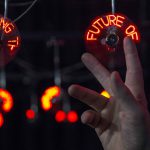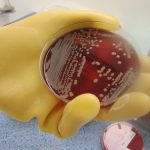All-Inclusive Cyborg Talks
The All-Inclusive Cyborg Talks are presented in the public program of ROBOT LOVE. The lectures and debates, looking at the phenomenon of cyborgism from different perspectives, deepen and sharpen the theme.
The talks take place during the Dutch Design Week 2018.
More or less abled with machines
Chair: Brendan Vos
Many people with disabilities have been greatly helped by robot technology. Think of the smart walker or exoskeletons. Not only can we remove the ‘dis’ out of disability, it enables people to even become smarter/more mobile/increase their senses. But is it indeed a step forward for everyone? Smart domotics and the internet-of-things can significantly limit possibilities for self-determination. Even with accessible interfaces, social innovation as a counterpart is desperately needed to empower people. Reserving resources to invest in this is as much crucial as the technological innovation.
Photo: Simone Giertz, Shitty Robots
Read more about the chair:
Brendan Vos
Brendan Vos currently holds a position as a teacher of English and Film at a secondary school. On his way getting there he has studied English Culture and Linguistics, and Film and Television, with specializations in semiotics and narratology. He also worked as a junior film programmer at Natlab_door_Plaza_Futura, curator at TEDxEindhoven and maintains two foundations on instigating and furthering dialogues on media and LGBTqueer issues, Mediahouse Eindhoven and DayDayGay respectively. The driving force behind his work is finding and communicating the (hidden) structures we find in the mundane – be it the languages we speak and own, or how we are still watching what we believe is television on our phones. Curating, lecturing or chairing a discussion as moderator, all go beyond instruction, as far as he is concerned. The point is to provoke, not only through shock, but preferably by laying bare true passion and emotion.
Read more about the speakers:
Joop Oonk & Jacqueline van Kuilenburg
Dancing with a mix of dancers with or without a disability, is called ‘inclusiondance’. Technology plays an important role for the concept development and educational purposes of the Misiconi Dance Company (MDC). For example, they often communicate via imagery and smartphones because not everyone reads or writes. The MDC has worked with Gopro’s, phones, walkie-talkies and remote-controlled cars. These are ‘simple’ tools that we can control manually, but can we take the leap and trust technology even more?
Jacqueline van Kuilenburg has been dancing for 3 years at the MDC and uses a Smart Drive in her daily life. The Smart Drive helps her to move more autonomously, as the apparatus literally gives her a push in the right direction. The same principle is used when people dance together, the one person moves the other, so an action/reaction cascade is set in motion. Jacqueline saves her energy and a special bodily language emerges. But what happens when we interrupt the technology or the Smartdrive? Are we looking for completion in our technologies or will we search for a new bodily language? And can we fully trust technology?
Joop Oonk is initiator and artistic director of the Misiconi Dance Company, and inclusive dance collective located in Rotterdam. The collective structurally works with an inclusive mindset. This means they work with dancers with mental, auditive, psychological and/or physical disabilities.
Hilde Meijs
The Summa College in Eindhoven, technology city, has been working for years to enrich health education with supportive care technology. Policymakers stimulate, among other things, the use of healthcare technology to limit the increasing healthcare costs and to strengthen people’s own management. Care technology suppliers indicate that virtually everything is possible in the technical field.
Yet all those beautiful applications are used only sparsely. What hinders this use or, in other words, how can we support people living comfortably safely at home longer? Do we focus on the question of the individual or the possibilities of the technique? Is it about quality of life or about operating buttons? And how do you do that in practice? I will gladly discuss this with you.
Björn Oddens
Robots, ‘big data’, cyborgs – they threaten, according to some, jobs, privacy, autonomy, perhaps even humankind. Nevertheless, we live – already today – better and longer thanks to robotics and technology. Man-machines (“cyborgs”) exist since Ǻke Senning implanted the first pacemaker in 1958. Premature neonates survive in automated incubators. We have been able to reduce infant death by programming our immune system to anticipate future infections (vaccination). Exoskeletons, cochlear implants and deep brain stimulation help us deal with ailments. Radiologists diagnose better because artificial intelligence helps them to interpret MRI scans. Surgeons extend their hands with precision robots. The discovery of new medicines has been aided by 3D insights in receptor structure, synthesis robots and assay automation. The future is here. It is not that scary.
Björn Oddens (1965) trained as medical doctor in Utrecht and epidemiologist in Amsterdam. He completed his PhD in Nijmegen and the executive development program of Wharton School (Philadelphia). Björn Oddens is Vice President General Medicine, Global Medical Affairs at MSD (Kenilworth, NJ, USA and Oss, NL). Since 2013 he is chairman of the supervisory board of NatLab in Eindhoven.
Arie Rommers
Robotic prostheses often give users back their pride and self-confidence, which they are often lost with the body part. One dares to get out of the closet with such a prosthesis, which previously had to seem lifelike, where the user had to act the rest of his life as if he or she had, for example, 2 real hands or arms. Every person in our country may happily come out of the closet with his or her sexual orientation, but may people with bionic limbs show their arms and legs? In addition, the technology has developed immensely over the past decades; where first a stiff doll hand was available, now titanium and carbon lightweight materials with modern electronics become the norm.
Arie Rommers is an artist and experience expert in bionic technology. Since a few years, he has a bionic hand and according to him makes his life and identity complete again. He regularly gives lectures on bionic technology, robots, and his story.
Location
Robot Love Expo Experience
Campina Milkfactory
At: Kanaaldijk-Zuid/Hugo van der Goeslaan
5613 LE Eindhoven
Date
Thursday, October 25, 2018
10.00 ’till 11.30 a.m.
Doors open: 9.30




